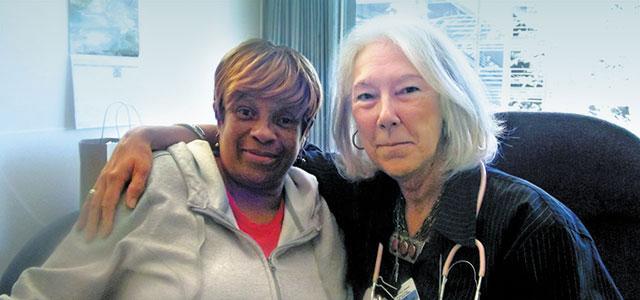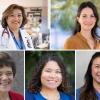
Deborah Royal, right, associate clinical professor, UCSF School of Nursing
What Volunteer Clinical Faculty Do: Deborah Royal at the East Bay AIDS Center
Volunteer clinical faculty and preceptors offer students individual perspectives and hands-on experience in a variety of health care settings and specialties. The cumulative effect of what these volunteers impart plays a significant role in the care any health system delivers. This series aims to shed light on the unique roles these valuable mentors play.
This month we hear from Deborah Royal, an associate clinical professor with UCSF School of Nursing, adult nurse practitioner and co-director of Women’s Services at the East Bay AIDS Center.
I got a broad liberal arts education at UC Berkeley and UC Santa Barbara but ended up in the basic sciences. In my mid-20s, I went into nursing at St. Luke’s Hospital School of Nursing and worked all over the Bay Area as an ICU nurse. I also completed a community health education program at San Francisco State University.
I left the US to travel for a year and a half, and when I returned the HIV epidemic was breaking out, and a number of my colleagues had died. The city of San Francisco funded a hospice program, and I was one of a number of critical care nurses who went into hospice work at that time because we had the skills to support critically ill patients at home.
I decided to go to grad school to become an NP (nurse practitioner), because I wanted to be able to provide medical care as well as nursing support to patients. I went back to school when a close-knit, committed group of young clinicians was developing care models for people with HIV/AIDS. I went through the Adult Nurse Practitioner program at UCSF, which at that time had developed a special concentration in HIV/AIDS.
I currently work at the East Bay AIDS Center in Oakland – the largest primary care clinic serving HIV-positive persons in the East Bay. We serve approximately 1,200 patients annually, about 325 women, including 20 transgender women. We also have a youth program that serves about 120, including some who were prenatally infected.
I deliver primary care, inclusive of managing HIV infection. As scientific breakthroughs have led to development of more effective and better-tolerated therapies, HIV has become a chronic manageable condition. The challenge is to engage patients in care before serious symptoms of illness present; that is, before significant deterioration of immune functioning. We now know that deterioration puts patients at risk of serious liver, kidney and heart disease, as well as opportunistic infections.
Unfortunately, there is still tremendous stigma attached to HIV. Even in 2012 many patients are unable to disclose their HIV diagnosis to others. Patients frequently cope with other forms of discrimination as well as the challenges of poverty. Food, housing and transportation are unmet needs for many in our inner-city community. All of this has led us to develop a “one-stop shopping” clinic in Oakland, inclusive of wraparound support services for our patients. Our team includes peer treatment advocates, medical social workers and mental health professionals.
The clinic is committed to a patient-centered model of care. Addressing patients’ basic needs for safety, security, confidentiality and hope is key to engaging them in treatment. Clinicians practice their active listening skills as well as their physical assessment and diagnostic skills. Deciding which medications to prescribe is often simpler than encouraging and motivating patients to elect treatment and confront other life issues. But those more challenging tasks are the essence of the work in primary care.
I was faculty on-campus for a year, many years ago, but now I customarily make a commitment to one second-year student for an academic year – second year because our patients are usually medically complicated.
Students usually do a weekly clinic. When they first arrive, they focus on eliciting the patient’s narrative and on assembling a comprehensive history and physical exam. They are just beginning to formulate differential diagnoses and learning disease management. They also work on presenting a client to me orally – history, physical exam findings and lab studies – and then they consult with me to begin arriving at their own assessments or diagnoses and identifying appropriate treatments. Midway, their focus shifts to developing shared decision making with patients. By the end of the year, students are able to apply what they’ve learned about diagnosis and management to develop patient-centered treatment plans.
I enjoy teaching. I love to see students grow in confidence and skill. As nurses, nurse practitioner students come into the UCSF program with a lot of experience. Their empathy and communication skills are well developed. Their focus is on learning medicine and shared decision making and helping patients make informed choices about their health.
It’s somewhat of an invisible skill set that NP students must develop – hearing patients’ perspectives, developing trusting relationships, honoring and supporting patients’ choices – while attempting to master evidence-based medical interventions. These skills are good nursing as well as good medicine.



